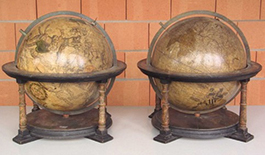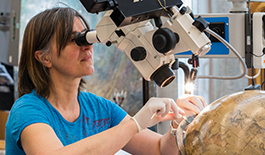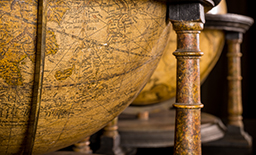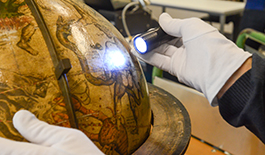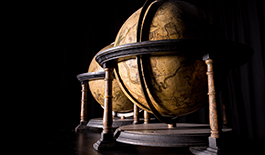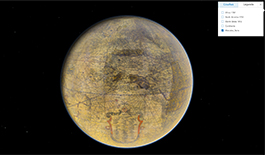Between the emergence from oblivion of a pair of 16th-century Mercator globes (2004), their scientific authentication and restoration (2015) and, finally, their showcasing (2016), a broad range of methods, techniques and expertise were brought to bear at UNIL through fruitful collaborations with partners in French-speaking Switzerland, Bern and Zurich. This section deals with the processes involved and the results that were obtained, at times mobilising unusual collaborations, in the globes’ exciting journey out of the shadows and into the spotlight.
The stages from beginning to end
Discovery
In 2004 two globes, overlooked until then, were reported at the University of Lausanne. Unfortunately, they were largely forgotten again until 2010…
Good heavens, two Mercator globes !
July 2004
Prof Bernard Hauck informs his colleague that there are two unidentified ancient globes in a room at the Physical Sciences building […]
The globes belong to UNIL
11 May 2005
Who owns these globes actually ? The University of Lausanne and the Cantonal and University Library sign an agreement […]
Two women enter the scene
Spring 2010
The project is relaunched by setting up a working group under the aegis of Unicom and with the support of the Faculty of Geosciences and the Environment […]
Capturing the globes in images
2011-2012
Laurent Dubois of the Cantonal and University Library of Lausanne at Dorigny photographs the globes for the first time in high definition […]
Authentication
The prime question was whether the globes are authentic. Thanks to a battery of tests and investigations by several experts, it was scientifically demonstrated that the globes are indeed genuine.
Dating the stands
August 2012
Samples are taken from the stands of the terrestrial and celestial globes for C14 radiocarbon dating. The relevance of the samples is ensured using dendrochronology (growth-ring analysis) […]
Sounding out an historian
13 June 2013
The project team meets with Dr Peter van der Krogt of the Universities of Amsterdam and Utrecht, an expert on Dutch globes of the 16th and 17th centuries […]
1875 facsimiles ?
June 2013
The project team meets with Dr Peter van der Krogt of the Universities of Amsterdam and Utrecht, an expert on Dutch globes of the 16th and 17th centuries […]
Dating the spheres
2013 and 2015
More samples are taken, this time from the two spheres’ surface paper and textile substrata, for AMS radiocarbon testing […]
The question of origin
When and by what route did the globes wind up at the University of Lausanne before emerging from oblivion at the dawn of the 21st century ? Numerous historical sources were consulted.
How did they come to Lausanne ?
1976
Bernard Hauck, a professor of astronomy at UNIL, remembers having moved the globes to Dorigny from the old premises of the Observatory on Chemin des Grandes-Roches […]
Inconclusive evidence
2005
Labels pasted on the underside of the two stands suggest the globes might have a connection to the History of Science Museum in Geneva. Yet there is no trace of the globes in its inventories […]
An intriguing theory
2005
Suppose the globes came to Lausanne thanks to one of the great scientific figures of the 18th century ? Unfortunately, this theory cannot be proved […]
Probing deeper
Investigations of the spheres’ inner structures with CT scans, X-rays, watermark studies, colour pigment analyses and stratigraphy rounded out the information already gleaned.
A strategy and more high-tech tools
June 2013
Experts from UNIL’s School of Forensic Science (ESC) are asked to devise a coherent strategy for further testing […]
A delicate trip to the CHUV
June 2013
The globes are taken to the Radiodiagnostics and Interventional Radiology department of the Lausanne University Hospital (CHUV) for a tomodensitometry (CT) scan. How will this first major transfer be handled ? […]
CT scan of the structure
June 2013
A series 578 computer tomodensitometry images were made of the terrestrial globe and 572 of the celestial globe to help better understand the spheres’ inner structure […]
X-rays of the structure
June 2013
At the Swiss Institute for Art Research (SIK|ISEA), Danièle Gros further analyses the globes’ structure using X-ray technology. This method highlights a number of additional details […]
Heterogeneous surfaces
March and June 2014
In a step that is indispensable for restoration work, UV fluorescence is used by Prof Dobruskin and Dr Scherrer of the Graduate School of the Arts in Bern (HKB|HEAB) to distinguish details of the spheres’ multi-layered shells […]
Surfaces and pigments
June 2014
A battery of scientific methods is brought to bear to determine what kinds of pigment were used to print the globes. The final report concludes that all the identified components were available in Mercator’s time […]
Stratigraphy of the spheres
2015
The successive layers forming the shells of the two spheres are studied by Karin Wyss, Dr Stefan Zumbühl, Nadim Scherrer and Margaux Genton at the Swiss Institute for Art Research in Zurich […]
Restoration
The task of consolidating and restoring the globes was assigned to the Swiss Institute for Art Research in Zurich. This final transfer was also an opportunity to perform further analyses…
Transfer to the Swiss Institute for Art Research
10 November 2014
The Institute for Art Research in Zurich is asked not only to restore the globes but also to analyse and summarise all the test results obtained thus far […]
Condition of the globes prior to their restoration
November 2014
The exact condition of the globes prior to their restoration is determined and described by the restoration manager. Her report reveals that the globes were already restored at an earlier unknown date […]
Restoration and conservation
2015
The globes are cleaned and consolidated by Margaux Genton, an assistant restorer at SIK|ISEA. The final report provides full details of the work performed […]
Computer-generated images in 3D
Dynamic 3D viewing opened a wide range of possibilities such as comparing Mercator’s cartography with that of other mapmakers, projecting the terrestrial globe on a planisphere and correcting distortions…
An original picture-taking system
February 2016
The specialists at the School of Forensic Science have to solve a number of problems inherent in photographing a spherical surface systematically and precisely […]
Georeferencing the images
March 2016
By digital georeferencing the high-definition images, a 3D model is created to reproduce each of the spheres virtually […]
